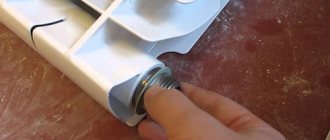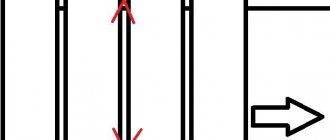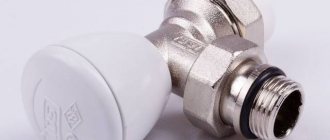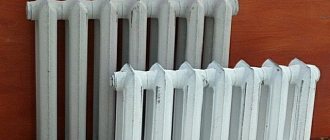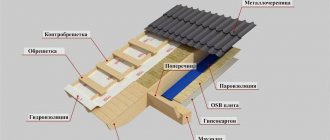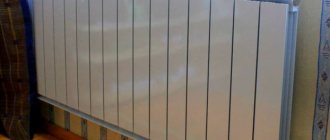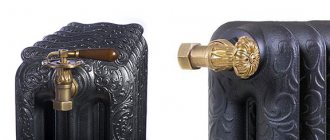How much water is in one section of an aluminum radiator, methods for calculating volume
Nowadays, replacing old cast-iron batteries with new models has become not a tribute to fashion, but a vital necessity. Concern for the safety of the heating system and attempts to reduce the cost of utilities have led to more and more consumers choosing aluminum radiators, which differ from other types of heaters in both technical characteristics and price. One of the important parameters is the volume of the heating radiator.
Parameters of aluminum radiators
The technical characteristics of heating batteries are the first thing a consumer pays attention to before purchasing. The most important indicators of a truly high-quality product are:
- The level of heat transfer of one section, since it depends on:
- First, how many elements are needed to heat one room.
- Secondly, how warm the room will be thanks to the radiator.
- Thirdly, what will the microclimate in the room be like?
- Resistance to water hammer and operating pressure of an aluminum radiator.
- Cost of the finished product.
The volume of one section of an aluminum radiator indicates its power and largely depends on how it was manufactured.
If the aluminum battery was made by pressing, then its parts were connected using glue, which makes it vulnerable. Such a radiator is not afraid of corrosion, but increased pressure can damage it.
The capacity of one section of an aluminum radiator, regardless of the method by which it was produced, is almost the same, but the fact that the cast model is stronger and more durable, heats up faster and can be adjusted in size puts them in first place in sales.
Types of coolants
As a rule, the question of what coolant is used in a centralized heating system is not asked, since water always flows through the heating pipe there. Another thing is autonomous heating, where you can choose the best option for a particular house, taking into account the climate of the region where it is built.
Why is radiator volume important?
Calculating how many liters are in one section of an aluminum radiator is important for several reasons:
Considering how many factors are affected by the volume of heating batteries, this parameter should be taken into account when choosing aluminum products.
Calculation of the volume of an aluminum radiator
There are two ways to determine the capacity of a heating battery:
This, although a very labor-intensive method, is the most reliable and accurate, since manufacturers can overestimate or underestimate the parameters of their products in the technical documentation.
When choosing the type of radiator, you should pay attention to the difference in the parameters of domestic and foreign manufacturers. Some indicators may look very attractive, but are not suitable for the centralized Soviet heating system
You also need to think in advance which coolant in the network will be used, and make calculations indicating its viscosity.
To summarize, we can say that the volume of an aluminum radiator is an important parameter that must be taken into account in order for the system to work truly efficiently in the future.
Technical aspects of aluminum batteries
To install an autonomous heating system, it is necessary not only to carry out installation work in accordance with current regulations, but also to choose the right aluminum radiators. This can only be done after a thorough study and analysis of their properties, design features, and technical characteristics.
Classification and design features
Manufacturers of modern heating equipment make sections of aluminum radiators not from pure aluminum, but from its alloy with silicon additives. This allows the products to be corrosion resistant, more durable and extend their service life.
Today, the retail chain offers a wide range of aluminum radiators, differing in appearance, represented by such products as:
- panel;
- tubular.
According to the constructive solution of a single section, which are:
- Solid or cast.
- Extruded or composed of three separate elements, internally secured to each other with bolts with foam rubber or silicone gaskets.
Batteries are also differentiated by size.
Standard sizes with a width of 40 cm and a height of 58 cm.
Low, up to 15 cm high, which makes it possible to install them in very limited spaces. Recently, manufacturers have been producing aluminum radiators of this series of “plinth” design with a height of 2 to 4 cm.
Tall or vertical. With a small width, such radiators can reach a height of up to two or three meters. This working height arrangement helps to heat large volumes of air in the room quite effectively. In addition, this original design of radiators also performs a decorative function.
The service life of modern aluminum radiators is determined by the quality of the source material and does not depend on the number of its constituent elements, their sizes and internal volume . The manufacturer guarantees their stable operation with proper use for up to 20 years.
Main performance characteristics
Comparative characteristics
Technical characteristics and design solutions of aluminum radiators are developed to ensure convenient and reliable heating of rooms. The main components characterizing their technical properties and operational capabilities are the following factors.
Operating pressure. Modern aluminum radiators are designed for coolant pressure in the heating system from 6 to 25 atmospheres. To guarantee these indicators, in the factory, each battery is tested at a pressure of 30 atmospheres. This fact makes it possible to install this heating equipment in any heating system where the possibility of water hammer formation is excluded.
Power. This indicator characterizes the thermodynamic process of heat transfer from the surface of the heating battery to the environment. It indicates how much heat in watts the device can produce per unit time.
By the way, heat transfer from aluminum radiators occurs by convection and thermal radiation in a ratio of 50 to 50. The numerical value of the heat transfer parameter of each section is indicated in the device passport.
When calculating the number of batteries required for installation, their power plays a primary role. The maximum heat transfer of one section of an aluminum heating radiator is quite high and reaches 230 Watts. This impressive figure is explained by the high heat transfer ability of aluminum.
Effect of connection on heat transfer
Section volume. This indicator characterizes the amount of coolant that is present in the radiator section in working condition. It depends on the overall dimensions of the radiator and its internal design. For each type and type of radiators, this value is different.
The volume of the section is an important technical characteristic of an aluminum radiator and must be indicated in the accompanying passport for each product from the manufacturer.
Due to the design features, to fill an aluminum radiator it is necessary to use a smaller volume of coolant compared to a cast iron device of the same power.
This means that it requires less energy to heat it than its cast iron counterpart.
The temperature range for heating the coolant in aluminum batteries exceeds 100 degrees.
As a reference, a standard section of an aluminum radiator with a height of 350–1000 mm, a depth of 110–140 mm, with a wall thickness of 2 to 3 mm, has a coolant volume of 0.35–0.5 liters, and is capable of heating an area of 0.4– 0.6 square meters.
Low batteries
Radiators with a small center distance have the following advantages:
- they can be placed under a low window sill;
- they have maximum heat transfer per unit area.
Cast iron radiators
.
The dimensions of the MS-140M-300-0.9 heating radiator sections are:
- length 93 millimeters;
- depth - 140 millimeters;
- height – 388 millimeters.
Due to their smaller dimensions, the heat transfer of cast iron heating radiators is reduced - it is equal to 106 watts from one section at an operating pressure of 9 kgf/cm². Among foreign analogues, there are cast iron products with an interaxal distance along the connections equal to 200 and 350 millimeters; the power of a section of a cast iron radiator of this type is much higher.
Aluminum radiators
. For low batteries made of aluminum, both domestic and imported, the spread of the center distances is quite large. You can find radiator sizes of 150, 300 and even 450 millimeters. Since the possible section length starts from 40 millimeters, the device looks compact and unusual. Low aluminum heating radiators have height dimensions starting from 200 millimeters. The depth of many models compensates for the lack of the other two parameters and is 180 millimeters.
As for thermal power, it varies from a minimum of 50 watts per section to a maximum of 160 watts. The determining factor is the fin area of one section. At the same time, the change in dimensions does not significantly affect the operating pressure - low aluminum devices are designed for 16 atmospheres, and when testing - 24 atmospheres. Bimetallic radiators
. All the sizes of heating radiators that they have are also typical for aluminum heating devices. Thermal power is within the same limits. On sale you can find aluminum low radiators with heat output of 80 and 140 watts per section. The working pressure is 25-35 atmospheres.
Bimetallic low radiators, such as in the photo, have two nuances:
- among heating devices there are batteries not with solid steel cores, but with steel tubes placed between aluminum collectors. Their operating pressure, indicated by manufacturers, is usually 12 or 16 atmospheres;
- they often do not have vertically located channels and, in the case of a lateral connection, can be heated by the collectors due to the thermal conductivity of aluminum. The circulation of the coolant is ensured by the last section, since it is flow-through.
The volume of water in an aluminum, cast iron, bimetallic heating radiator
There are many reasons why you may need to know the volume of water in a heating radiator. The easiest way is to look at the specifications, instructions or other documentation for the product. But what to do if it is not there?
From this article you will learn how many liters of water are in one section of a heating radiator, depending on its model and dimensions. We will also tell you how to calculate this indicator for non-standard models.
How much water is in one section of a cast iron radiator?
Cast iron batteries differ in section height, depth, power and weight. For example, the MC 140-500 model has a height of 50 mm and a depth of 140 mm. Basically, the volume of water in the cast iron section of the radiator is affected by its height.
The most common is the MS series. Depending on the manufacturer, the volume of coolant may vary, so there is a slight scatter.
Volume of one section of the MS brand (in liters)
- MS 140-300 – 0.8-1.3,
- MS 140-500 – 1.3-1.8,
- MS-140 – 1.1-1.4,
- MS 90-500 – 0.9-1.2,
- MS 100-500 – 0.9-1.2,
- MS 110-500 – 1-1.4.
Cast iron batteries of the ChM series are very popular. The model marking indicates the number of channels, height and depth of the section. For example, ChM2-100-300 has a height of 300 mm, a depth of 100 mm, and water circulates in it through two channels.
Volume of water in one section of the ChM brand (in liters)
- World Cup1-70-300 – 0.66,
- World Cup1-70-500 – 0.9,
- World Championship2-100-300 – 0.7,
- World Championship2-100-500 – 0.95,
- World Championship3-120-300 – 0.95,
- World Championship3-120-500 – 1.38.
Water volume in one section of an aluminum radiator
There are dozens of manufacturers of aluminum heating radiators, the products of each of them differ in the design and size of the internal channels. Therefore, we can only approximately say how much water is in one section of an aluminum radiator.
The main difference between the models is in height, so here is a list of the most common sizes (data are given in liters):
- 350 mm – 0.2-0.3,
- 500 mm – 0.35-0.45,
- 600 mm – 0.4-0.5,
- 900 mm – 0.6-0.8,
- 1200 mm – 0.8-1.
For non-standard sizes, you can use the formula (V – volume in liters, h – height in meters):
V = hx 0.8
The result will be approximate, but if you don’t have the equipment specifications at hand, you can use the obtained value. This way you can determine how much water is in one fin of an aluminum battery with an error of no more than 20%.
Please note that the capacity of an aluminum heating radiator may decrease over time due to corrosion. It is formed due to water with poor alkalinity or acidity. Also, the volume of liquid in an aluminum radiator may be reduced due to silting.
How much water is in one section of a bimetallic radiator
As with aluminum, there are many options for manufacturers and brands of bimetallic radiators. Their structure, appearance, and channel diameters differ in the same way.
The volume of water in a bimetallic radiator depends on its height and is (in liters):
- 35 cm – 0.1-0.15,
- 50 cm – 0.2-0.3,
- 60 cm – 0.25-0.35,
- 90 cm – 0.3-0.5,
- 120 cm – 0.4-0.6.
To calculate the volume of a section of a bimetallic radiator of non-standard height, use the formula (V – volume in liters, h – height in meters):
V = hx 0.35
This will give you an approximate value, which may vary within 20%.
The amount of coolant in the heating battery
The correctly selected volume of coolant in the section allows the heating radiator to operate most optimally. The amount of water in the radiator affects not only the operation of the boiler, but also the efficiency of all elements of the heating system. The most rational selection of other equipment included in the heating system also depends on the correct calculation of the volume of water or antifreeze.
The volume of coolant in the system also needs to be known in order to select the correct expansion tank. For houses with a central heating system, the volume of radiators is not so important, but for autonomous heating systems, the volume of water in the radiator sections needs to be known for certain. You also need to take into account the volume of the heating system pipelines so that the heating boiler operates in the correct mode. There are special tables for calculating the internal volume of heating system pipelines. You just need to correctly measure the length of the heating circuit pipes.
Today, radiators made of bimetal and aluminum alloy are most in demand. A bimetallic radiator section with a height of 300 millimeters has an internal volume of 0.3 l/m, and a section with a height of 500 millimeters has a volume of 0.39 l/m. The radiator section made of aluminum alloy has the same indicators.
Radiators made of cast iron are also still in use. An imported cast iron section with a height of 300 millimeters has an internal volume of 0.5 l/m, and the same section with a height of 500 mm already has an internal volume of 0.6 l/m. Domestic cast iron batteries with a height of 300 mm have an internal volume of 3 l/m, and a section with a height of 500 mm has a volume of 4 l/m.
Water or antifreeze
Ordinary water is most often used as a coolant, but antifreeze and distillate are also used. Antifreeze is used only if the residence in the house is not permanent. Antifreeze is needed when the heating system does not work in winter. Using antifreeze as a coolant is much more expensive than using ordinary water. In order not to spend extra money when using antifreeze as a coolant, you need to know exactly the volume of the heating system. You should count the number of radiator sections and calculate the volume of heating batteries using the above parameters. The volume of the pipeline is determined using a special table. But to do this, you first need to measure the length of the pipes with a regular tape measure.
At the end of the calculations, the volume of pipelines and the volume of heating radiators are added together, and based on these data, the required amount of antifreeze is purchased. This data will also be useful for determining the amount of water to be used in the heating system. This information will allow you to configure the heating boiler, as well as other elements of the heating circuit, in the most flexible way.
Storage and wear processes
In order to reduce the risk of deterioration of battery performance during long-term storage, you must adhere to the following rules:
- do not allow complete discharge;
- storage temperature is not lower than -20 °C and not higher than +30 °C;
- charge annually for 48 hours;
- The battery surface must be clean to avoid self-discharge.
The main processes that destroy a lead-acid battery:
- Sulfation is the formation of crystals of lead salts. They are deposited on the plates and prevent the normal passage of current.
- Corrosion is an oxidative process that destroys the lead electrodes of a battery.
- Shedding - the active mass in the cells of the positive electrodes loses normal adhesion to the base and falls off.
- Adhesion defects also lead to the sliding of the powdery contents of the conductive plates.
Failed batteries cannot be repaired and must be recycled. Vapors of heavy metals can cause serious harm to humans and the environment, so artisanal smelting of lead from batteries is life-threatening.
Answers from experts
Chairman:
5 square meters
Verik:
cast iron heats, and aluminum transfers heat to the water in the radiator.. 350 mm is a stretch of 8 squares
Truculentus:
The passport for the radiator indicates the thermal power of one section of the radiator (for sectional batteries) or the same indicator of the entire radiator. This indicator differs for different manufacturers.
In practice, an approximate calculation is usually used, based on the fact that for heating 10 sq.m. a normally insulated room with a ceiling height of up to 3 m requires 1 kW of thermal power (100 W/sq.m). For corner rooms (2 external walls), rooms with large windows (or several windows), the obtained value is increased by 20-25%.
Grandfather Au:
look at how many watts it is according to the instructions, divide by 100, multiply by 0.8 and you will get square meters (the same with any radiator)
Vladimir Petrov:
As I understand it, 350 is the interaxial distance and how many sections there are. Look on the Internet in the section. There are a bunch of batteries there, you can take their power rating data. And then consider about 150 watts per square meter. I have about 14 square meters on the terrace at my dacha. m there are two batteries of 12 sections 350mm. I took it with a reserve. The windows are large, 2400 x 140, two of them; I have a winter garden there. It's even hotter when it's minus 25 outside.
Pretzel:
For 10 square meters of a house there is approximately 1 watt. at 24, respectively, 2.4 watts. One section is approximately 150-200 watts. Approximately 12-15 sections are needed. I have a house of 120 square meters, sections 5+5+5+10+5 = 30 second floor and 7+5+5+5=22 + warm floor first floor
Truculentus:
To heat a typical room in a 1 m³ panel house, 0.041 kW of thermal energy is required. To heat a room in a brick house with wall insulation (mineral wool, foam plastic) and installed double-glazed windows on 1 m³, 0.034 kW of thermal energy is required. A double-glazed window will reduce heat loss by 15-20%; accordingly, the number of sections can be reduced. If the room is corner, then heat loss will be approximately 20% greater. For premises built in accordance with the latest building regulations, 0.020 kW of thermal energy is required per 1 m³. Any radiator has information about the thermal power on the packaging or in the included insert.
Frosya Burlakova:
You can approximately determine how many radiator sections are needed if you multiply the area of the room by 100 and divide by the heat transfer of the section (according to the passport) in W. It should be remembered that the obtained value is approximate and a number of factors are not taken into account (heat losses of the room, heating network parameters and types of radiator connections). 15 approximately
uncle Ivan:
At least 14, and it is better to install two blocks of 8 sections.
Andrey:
There is not enough data for a correct answer. Please indicate: 1. the difference in temperature between your comfortable temperature and the minimum winter temperature for your region. 2. the amount of heat loss from the surfaces of the heated room 3. the rate of air exchange from the room to the street and adjacent rooms 4. Connection diagram for radiators. 5. how many windows are there in the room? 6. Estimated temperature of the supply and return pipelines. 7. circulation speed and coolant type. 8. Thermal power of the section declared by the manufacturer and at what temperature conditions. 9. You can also add pressure in the system, but this is nitpicking since the effect on heat transfer is insignificant. We are waiting for the data and will immediately issue an accurate answer.
MurYska:
oh wow, what sophisticated answers)))))) we thought so for 2 square meters 1 section, now in the apartment it’s 28-30C in the winter before the renovation it was 20-22
Grandfather Au:
per square meter you need 100 watts, especially in a panel house! DO NOT take aluminum - especially if the high-rise building breaks! and they don’t like our water very much
Smirnov Vladimir:
The required number of sections is determined by the formula: S rooms * H ceilings * window coefficient (35 - if double-glazed windows, 40 - if regular windows) / section heat transfer = number of sections. Aluminum radiators have a heat output of 190 watts
Valentina Bryzgalina:
The locksmith spoke. “What’s the point of installing many sections, if the pressure is small, it will not push through to the end. “This often happens, because (zheki, reu) have big savings on this. I changed batteries and wanted 10-12 pcs. put in a room of 18 sq. m. As a result, they installed 8 pieces, the circulation is good, it’s warm. Aluminum ones last 6 years.
Ivan Krasnoshchok:
I used the table, see the Kermi website. about (only in English letters) is very convenient and sensibly written.
Egor Lvov:
why do you want it?
How to calculate the volume of water in the heating system, radiators, pipes.
Calculating the volume of water (coolant) filling the heating system will be one of the first things when choosing a boiler.
This is necessary to understand what optimal volume your boiler or other heat source can heat. The parameters of the pipes greatly influence this indicator: if you have a pump, you can safely choose a pipe of a smaller diameter and install more heating sections.
If you choose pipes of large diameter, then at maximum boiler power you can get underheating of the coolant: a large volume of water will cool down sooner before reaching the extreme points of the heating system. Which in turn will lead to additional financial costs.
An approximate calculation of the volume of water in the heating system is made from the ratio of 15 liters of water per 1 kW of boiler power.
To determine how much water is needed for a home heating system, consider a simple example.
The boiler power is 4 kW, then the system volume is 4 kW * 15 liters = 60 liters. But it is necessary to take into account the size and number of radiator sections.
If you have a house with 4 rooms, this does not mean that you need to put 12-15 sections in each: it will be very hot and the boiler will not work efficiently. If there are more rooms, then you shouldn’t save on radiators: 1 modern section effectively gives off heat for 2...2.5 m2 of area.
Formulas for calculating the volume of liquid (water or other coolant) in the heating system
The volume of water in the heating system can be calculated as the sum of the components:
The volume of the system must take into account the volume of water in the pipes, boiler and radiators. The calculation of coolant volume does not include the volume of the expansion tank. The volume of the tank is taken into account when calculating critical states of system operation (when water will flow into it when heated).
Formula for calculating the volume of liquid in a pipe:
Modern models of heating radiators
For mounting on walls, various manufacturers have developed new models made of gray cast iron; their weight is much less than the old classic models.
For example, let's describe the Czech heating radiator Viadrus STYL 500. How much does 1 section of this heating radiator weigh? And how much will the mass of the entire structure be? The weight of 1 section is 3.8 kg. water holds 0.8 liters, so the weight of one radiator section with water will be 4.6 kg. With a heat flux of 140 W, to heat a room of 20 m2, 14 sections will be required; the corresponding weight will be 64.4 kg with water. Thus, this figure differs by 40% less than that of the classic MS 140 sample. If this value is divided into two parts (32 kg each), then we can conclude that installation on walls made of modern materials, including porous concrete, It is quite possible to carry out without additional fasteners.
An even lighter design was developed by Russian manufacturers. Their heating devices are offered under the EXEMET brand. The MODERN model has the following weight characteristics:
One section from this manufacturer weighs 3.2 kg, heat output is 93 W. To heat a room of 20 m2 you will need 22 sections, then the total weight will be 70.4 kg. These parameters are not bad, especially considering that the company produces models with possible installation on the floor.
A few words about the vintage cast iron battery. Its weight exceeds the Soviet model, which can reach 14 kg. These heating devices look very much like the old ones that were installed in residences and estates back in the 19th century.
The EXEMET FIDELIA model weighs 12 kg, heat dissipation is 156 W, the total mass of the device for our example is simply monstrous - 154 kg. The complex issue of installation is irrelevant here, since the first and last sections are equipped with legs for placing the device on the floor.
So, in order to ensure uninterrupted service for the heating system, you cannot ignore such important indicators as the weight and volume of the battery section. Thanks to the correct calculation of the load on the fastening elements, you can count on reliable installation and long-term operation of the device.
Answers from experts
Chairman:
5 square meters
Verik:
cast iron heats, and aluminum transfers heat to the water in the radiator.. 350 mm is a stretch of 8 squares
Truculentus:
The passport for the radiator indicates the thermal power of one section of the radiator (for sectional batteries) or the same indicator of the entire radiator. This indicator differs for different manufacturers.
In practice, an approximate calculation is usually used, based on the fact that for heating 10 sq.m. a normally insulated room with a ceiling height of up to 3 m requires 1 kW of thermal power (100 W/sq.m). For corner rooms (2 external walls), rooms with large windows (or several windows), the obtained value is increased by 20-25%.
Grandfather Au:
look at how many watts it is according to the instructions, divide by 100, multiply by 0.8 and you will get square meters (the same with any radiator)
Vladimir Petrov:
As I understand it, 350 is the interaxial distance and how many sections there are. Look on the Internet in the section. There are a bunch of batteries there, you can take their power rating data. And then consider about 150 watts per square meter. I have about 14 square meters on the terrace at my dacha. m there are two batteries of 12 sections 350mm. I took it with a reserve. The windows are large, 2400 x 140, two of them; I have a winter garden there. It's even hotter when it's minus 25 outside.
vyachko:
Based on the empirical average ratio of 1 kW per 10 sq. m area, then. For example, for a room of 20 square meters. m you need a battery with a total power of 2 kW. One section of an aluminum radiator with a center distance of 500 mm at a temperature difference of 70 degrees produces 140...200 W (need to be clarified for the specific brand of radiator). For 2 kW we get somewhere around 10…14 sections.
Vyacheslav Koshelev:
and there is nothing more to answer...
BOSS:
Read SNiP heating engineering. The number of radiators depends not so much on the area, but on the heat loss of the room (on the correctness of the chosen enclosing structures: walls, floors, ceilings). Everyone protects a private house from the evil one... (from money in his pocket). If you insulated and built it correctly... then consider it as written above... if not, then refer to the calculator and SNiP.
Farit Gafuanov:
in short, one section, two squares, to be sure, take two more sections
Andrey:
Find out the rated thermal power of the section (all manufacturers indicate it for a supply of 90 degrees) divide 90 by the calculated supply temperature, you will get a reducing coeff. Using the tables, determine the approximate heat loss of one square meter of your walls and multiply by their outer area. , add the heat loss of the Windows (tabular data multiplied by the area), add the heat loss of the ceiling, depending on the type of insulation or the presence of neighbors above, they vary greatly. Add heat loss to supply and exhaust ventilation. Set up a winter regional co-off. air temperature and indoor temperature that is comfortable for you. Based on this temperature difference and the amount of heat loss in the room, you determine how many kilowatts are required to maintain this temperature, divide these kilowatts by the actual power of the section and find out the minimum number of sections. The principle is simple; The more sections and the lower their temperature, the more efficient the heating.
Irina Manaeva:
1 section for 2-3 sq. m.
Oleg Khrebtov:
I always put 1 section at 1.5m. sq. Enough even in severe frosts..
MIKA:
BOSS said everything correctly, we calculate the heat loss of the premises
Maria:
Take it with a reserve - you can tighten the valves. It wouldn’t hurt to put it in the corners either - outside corners and at the entrance for a pillow.
Gennady Skvortsov:
It’s nice to read the opinions of experts, I would like to add only about the priority location under windows and entrance doors
Pavel Pavlov:
bet the more the better... be realistic - if you are not an expert, why the hell will you calculate possible heat losses and other bullshit, it is better to proceed from what pressure you have in the pipe - how many sections it can push through. but it will be hot, turn down the heat, and this again saves gas...
The volume of water in the heating system: how to calculate and what does it affect?
Volume of water in the heating system
Many of us, faced with the installation or reconstruction of a heating system, wonder how to calculate how much water is in the heating system?
The answer is simple - take a sheet of paper, a pen and a calculator. First of all, you need to understand that the total volume will be equal to the sum of the volumes of each element of the system. Below we provide the values for the most common elements.
Calculation of coolant in radiators:
- Type 11 – 0.25 l for every 10 cm of radiator length (for radiator models with a height of 500 mm)
- Type 22 – 0.5 l for every 10 cm of radiator length (for radiator models with a height of 500 mm)
If you need to calculate the volume for radiators of non-standard height (for example, 300, 400, 600 mm), use the interpolation method. For example, the volume of a heating radiator of type 22 with a height of 300 = 0.5 l / 500 * 300 = 0.3 l. Depending on the manufacturer, the data may fluctuate, but not significantly.
For sectional radiators:
Amount of coolant in pipes:
- dia. 20 mm – 0.17 l/meter running pipe
- dia. 25 mm – 0.3 l/m
- dia. 32 mm –
- dia. 40 mm –
- dia. 50 mm –
- dia. 1/2 inch (15 mm) – l/meter running pipe
- dia. 3/4 inch (20 mm) –
- dia. 1 inch (25 mm) –
- dia. 1.5 inches (40 mm) –
- dia. 2 inches (50 mm) –
Volume of water in the boiler
For floor and parapet, depending on the power and, accordingly, the size of the boiler, the value ranges from 10-30 liters. You can be more precise by looking at the characteristics of the device itself.
In this simple way, adding up all the values. we can determine the volume of the system.
Note:
It would be advisable to calculate the amount of coolant in the system if:
- we determine what volume we need an expansion tank
- how much coolant do we need (if we fill in antifreeze)
- we choose a circulation pump
- theoretically I admit that I missed something. If you find this, write me an email and I will definitely take it into account!
There is absolutely no point in calculating the volume in order to:
- calculate how much less gas consumption will be if pipes are replaced with radiators (there is a relationship, but it is not directly proportional, the calculation will not be correct).
- select boiler power. Choosing a boiler based on the amount of water in the system is not logical. After all, our ultimate goal is not to provide heating of water, but to compensate for the heat losses incurred by our building.
This is a simple way to calculate the volume of coolant in the heating system. I hope the article was useful. Warmth and comfort to you!
The volume of water or coolant in various pipelines, such as low-density polyethylene (HDPE pipe), polypropylene pipes, metal-plastic pipes, steel pipes, must be known when selecting any equipment, in particular an expansion tank.
For example, in a metal-plastic pipe with a diameter of 16, a meter of pipe is 0.115 g. coolant.
Did you know? Most likely no. And why do you actually need to know this until you are faced with the selection of, for example, an expansion tank. Knowing the volume of coolant in the heating system is necessary not only for selecting an expansion tank, but also for purchasing antifreeze. Antifreeze is sold undiluted to -65 degrees and diluted to -30 degrees. Once you know the volume of coolant in the heating system, you can buy an even amount of antifreeze. For example, undiluted antifreeze must be diluted 50*50 (water*antifreeze), which means that with a coolant volume of 50 liters, you will need to buy only 25 liters of antifreeze.
We present to your attention a form for calculating the volume of water (coolant) in the pipeline and heating radiators. Enter the length of a pipe of a certain diameter and instantly find out how much coolant is in this section.
What should the dimensions be?
In order for the heating radiator to give off maximum heat (in this case we are not talking about its thermal power, but about the efficiency of its operation), the dimensions must be as follows:
- The length should be more than 70-75% of the width of the window opening.
- The height should be such that there is 8-12 cm between the floor and the battery, and 6-12 cm between the window sill and it.
If the recommendations are not followed, the operation of the aluminum radiator will be accompanied by heat loss. Therefore, even if he can provide the necessary for a room with an area of 20 square meters. m 200 watts of heat, then due to incorrect dimensions there will be insufficient heat in the room. After all, part of it may be lost under the windowsill or used to heat the floor.
When the length is less than 70% of the width of the window opening, the battery will not be able to create a thermal curtain capable of blocking the movement of cold air entering through the window. The consequence of this situation will be the appearance of cold and warm zones in the room. Also, the windows will be constantly covered with steam. And even the power of the heating radiator, which is greater than the need, cannot become a “magic wand”.
Therefore, if the window is 2 m wide, then the length of the battery should be at least 1.4 m
Of course, in order to select a device with such a length, you will need to take into account sections of different heights and their heat transfer. The calculation may take a long time, but it is worth it
Aluminum radiator section power
Many people note that in the formula for calculating the number of sections, you can substitute the power of the heating radiator section that the manufacturer indicated in the technical documentation. This idea is correct when a coolant with a temperature of 100 °C circulates in the heating system and is cooled to 80 °C. The fact is that manufacturers indicate the heat transfer of the battery under the condition ΔT = 70 °C. They calculated this indicator based on the formula:
- where t1 represents the inlet coolant temperature,
- t2 is the coolant outlet temperature,
- t3 represents the room temperature of the house.
ΔT = 70 °C only when the coolant has the above temperature levels and t3 = 20 °C.
After that, they take a special plate in which the manufacturer indicated the heat transfer of the radiator at different ΔT, and look for the resulting indicator. Next to it is a correction factor. For example, for ΔT = 50 ° C it is 0.65. This figure is multiplied by the power of the radiator section. Next, the obtained result can be substituted into the formula indicated at the very beginning.
Calculation example
If you calculate how many sections of an aluminum radiator are needed for a room with an area of 20 m2 at a rate of 100 W/m2, then adjustment coefficients for heat loss should also be made:
- each window adds 0.2 kW to the indicator;
- the door “costs” 0.1 kW.
If it is assumed that the radiator will be placed under the window sill, then the correction factor will be 1.04, and the formula itself will look like this:
Q = (20 x 100 + 0.2 + 0.1) x 1.3 x 1.04 / 72 = 37.56
- the first indicator is the area of the room;
- the second is the standard number of W per m2;
- the third and fourth indicate that the room has one window and one door;
- the next indicator is the heat transfer level of the aluminum radiator in kW;
- the sixth is a correction factor regarding the location of the battery.
Everything should be divided by the heat output of one heater fin. It can be determined from the table from the manufacturer, which shows the heating coefficients of the carrier in relation to the power of the device. The average for one edge is 180 W, and the adjustment is 0.4. Thus, multiplying these numbers, it turns out that one section produces 72 W when heating water to +60 degrees.
Since rounding is done upward, the maximum number of sections in an aluminum radiator specifically for this room will be 38 fins. To improve the performance of the structure, it should be divided into 2 parts of 19 ribs each.
Find out useful information about aluminum batteries on our website:
Aluminum heating devices
Specifications
Note! If you want to purchase quality products, then when purchasing, pay attention to its weight. Thus, the instructions indicate that the mass of one section cannot be less than a kilogram, and the assembly of a ten-section battery, including nipples, cannot be less than 11 kg!
Sectional view of the device (extrusion)
The volume of one section of an aluminum radiator largely depends on the method of its manufacture, and there are only two such methods - casting and extrusion.
- Experts consider the production of products using the injection molding method to be more technologically advanced - it allows you to obtain an all-welded sectional body . Of course, there is a seam, but it is performed by resistance welding. Of course, the price of such products is somewhat higher.
- But the pressing or extrusion method is a process when several elements are squeezed out of an alloy with a very high Al content (98%) . Their connection is made mechanically and high quality glue is used. Products obtained by extrusion are highly resistant to corrosion, and their main disadvantage (weak point) is the mechanical joining method.
Production line for painting radiators in Zlatoust
- Not only the volume of water in an aluminum heating radiator, but also its shape – ribbed and sectional – helps determine the operational properties . The ribbing allows for the maximum possible contact with the air in the room, which contributes to its rapid heating, and the sections allow the device to be reduced or enlarged as needed, depending on the volume of the heated room.
- In addition, protection against corrosion is painting the products in two layers . Painting work is usually carried out on specialized production lines, which are operated by only a few people (see photo above). Such processes are carried out in two stages - first, the first layer is applied using anaphoresis, which provides anti-corrosion protection and color stability for the next coating. The second layer is already sprayed with powder enamel, which is what we see on the finished product.
| Name | Distance between axles (mm) | Dimensions (mm) | Collectors Diameter (inch) | Heat transfer coefficient | Water volume in section (l) | Heat dissipation (W) | Weight |
| GLOBAL CLASS | 800 | 80x80x882 | 1/2-3/4 | 5,58 | 0,59 | 254 | 2,16 |
| 700 | 80x80x782 | 1/2-3/4 | 5,83 | 0,54 | 232 | 1,91 | |
| 600 | 80x80x682 | 1/2-3/4 | 6,0 | 0,49 | 204 | 1,66 | |
| 500 | 80x80x585 | 1/2-3/4 | 6,44 | 0,44 | 187 | 1,41 | |
| 350 | 80x80x432 | 1/2-3/4 | 6,76 | 0,37 | 131 | 1,01 | |
| GLOBAL VOX | 800 | 80x80x890 | 1/2-3/4 | 5,69 | 0,56 | 276 | 2,21 |
| 500 | 80x80x590 | 1/2-3/4 | 6,34 | 0,46 | 193 | 1,45 | |
| 350 | 80x80x440 | 1/2-3/4 | 6,79 | 0,35 | 145 | 1,12 | |
| GL 200/80/D | 200 | 80x80x290 | 1/2-3/4 | 7,79 | 0,52 | 165 | 1,42 |
| GL 350/80/D | 350 | 80x80x440 | 1/2-3/4 | 7,19 | 0,7 | 247 | 2,21 |
| GLOBAL VIP | 500 | 80x80x590 | 1/2-3/4 | 6,37 | 0,43 | 195 | 1,62 |
| 350 | 80x80x440 | 1/2-3/4 | 6,73 | 0,35 | 147 | 1,3 | |
| GLOBAL VIX R | 500 | 80x80x590 | 1/2-3/4 | 6,49 | 0,43 | 190 | 1,16 |
| 350 | 80x80x440 | 1/2-3/4 | 6,8 | 0,36 | 145 | 1,57 | |
| GLOBAL ISEO | 500 | 80x80x582 | 1/2-3/4 | 6,56 | 0,44 | 180 | 1,31 |
| 350 | 80x80x432 | 1/2-3/4 | 6,93 | 0,34 | 152 | 1,05 | |
| 600 | 80x80x682 | 1/2-3/4 | 6,35 | 0,47 | 203 | 1,5 | |
| 700 | 80x80x782 | 1/2-3/4 | 6,16 | 0,52 | 232 | 1,68 |
Table: dimensions, weight, heat dissipation and volume of the aluminum radiator section
We carry out power calculations
Note. In order for all calculations to correspond to reality, the location where you are going to install the radiator is important. So, as a rule, this is done under the window - warm air from the heating device, rising upward, creates a kind of screen that protects the room from cold currents moving from the glass.
Battery under the window in operating mode
So, calculating the volume of water in an aluminum radiator, as you understand, does not pose any problem - to do this, it is enough to know the volume of one section and their number, and then add these values together (see table).
In the same way, you can determine the battery power if you know the nominal value of one section and their number, but let's see how to calculate this indicator for a room of a certain size.
If the ceiling height does not exceed 2.7 m, then calculations can be carried out by quadrature, and for example we will take a room with an area (S) of 4.5 × 5.5 m, then S = 4.5 * 5.5 = 24.75 m2, and use a GLOBAL KLASS radiator with a section power of 232 W.
To calculate the number of sections, we need the formula S*100/P, where 100 is the required number of watts per square meter, and P is the power of one section. This means, Knumber of sections = S * 100 / P = 24.75 * 100/232 = 10.66 or 11 sections (the volume of water in one section of the aluminum radiator is 0.54 l, which means 0.54 * 11 = 54.54 l) .
Now let’s take the parameters of the same heating device and the same area, but the ceiling height is 3m, then we will need to make calculations per m3, where 41W of heat transfer is required.
The volume of the room (V) turns out to be 4.5*5.5*3=74.25 m3, which means we divide it by the power of one section. We will get Knumber of sections=V*41/P=74.25*41/232=13.1 or 14 sections to have a reserve.


